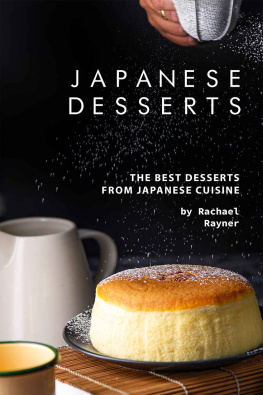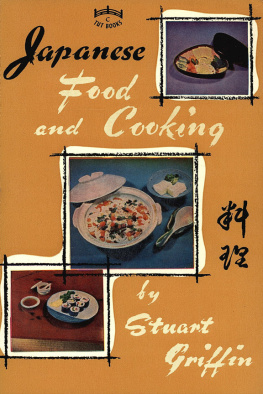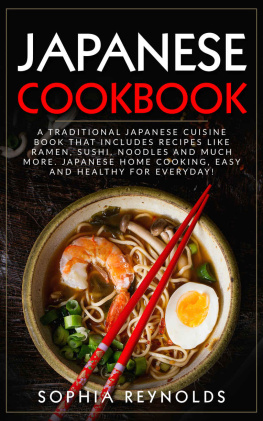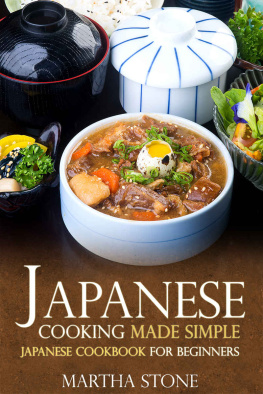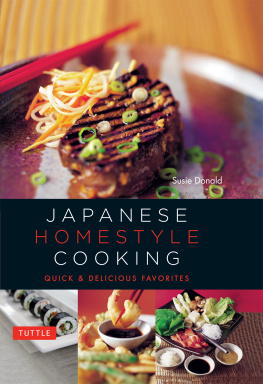Acknowledgments
I would like to thank the friends, old and new, who have given me such generous help with this book. To no one is my debt more profound than to my collaborator, Mitsuko Endo, who truly opened the door of the Japanese kitchen to me, and to her husband, Takashi Endo, ever ready to help with language problems, and to their children, Taketo and Yoko, who helped evaluate our cooking.
I have lost touch with many Japanese friends from the past, and I hope they will forgive me. My thanks to Mr. and Mrs. Takeshi Fukui, Mr. and Mrs. Hirofumi Shinozuka, Mr. and Mrs. Tatsuo Shiraki, Mr. and Mrs. Naoya Yoshida, and Mr. and Mrs. Katsumi Shiraishi for having encouraged my initial interest during visits to Japan.
I would like to give very special thanks to my friend Dr. Alex D. Hawkes, the noted botanist and cookbook author, who has been unfailingly generous in helping me identify Japanese herbs and vegetables.
My thanks also go to Miss Yoko Yoshida for secretarial help.
Menus
Breakfasts
Gohan (PLAIN BOILED RICE)
Kaki Dfu Jiru (OYSTER AND BEAN CURD MISO SOUP)
Sakana No Misozuke-Yaki (FISH MARINATED IN BEAN PASTE)
Kyrimomi (CUCUMBER SALAD)
Hakusai To Ninjin No Kaorizuke (CHINESE CABBAGE AND CARROT PICKLES)
Gohan (PLAIN BOILED RICE)
Wakame Jim (MISO SOUP WITH LOBE-LEAF SEAWEED)
Wakasagi No Nanbanzuke (PICKLED SMELT)
Hrens No Ohitashi (SPINACH SALAD)
Luncheons
Hiyamugi (CHILLED NOODLES WITH EGGS)
Sawara No Teriyaki (GLAZED KING MACKEREL)
Green Asparagus No Kimijyukake (GREEN ASPARAGUS SALAD)
Oyako Donburi (PARENTS AND CHILDREN RICE)
Tfu To Shungiku No Misoshiru (MISO SOUP WITH SHUNGIKU)
Kyri To Moyashi No Goma-ae (CUCUMBER AND SOY BEAN SPROUTS WITH SESAME SEEDS)
Dinners
Spring
Gohan (PLAIN BOILED RICE)
Tfu To Wakame No Suimono (CLEAR SOUP WITH OKRA AND BEAN CURD)
Toriniku Dango No Terini (GLAZED CHICKEN BALLS)
Takenoko No Tamago-Toji (EGGS WITH BAMBOO SHOOTS)
Na-No-Hana No Gama-ae (RAPE BLOSSOMS WITH SESAME SEEDS)
Summer
Tempura (BATTER-FRIED SHRIMP AND VEGETABLES)
Toriniku No Oroshi-ae (CHICKEN AND VEGETABLE SALAD)
Okura To Hari Shga No Suimono (CLEAR SOUP WITH OKRA AND GINGER)
Gohan (PLAIN BOILED RICE)
Sokuseki Misozuke (INSTANT-PICKLED VEGETABLES WITH BEAN PASTE)
Autumn
Hirame No Kohaku-age To Ebi No Iga-age (NOODLE-COATED SHRIMP WITH FRIED SOLE)
Nasu No Misoni (EGGPLANT WITH BEAN PASTE)
Gohan (PLAIN BOILED RICE)
Noppei-jiru (VEGETABLE AND FRIED BEAN CURD SOUP)
Winter
Karei No Karaage (DEEP-FRIED CRISPY FLOUNDER)
Kya-mushi (BEAN CURD, CHICKEN AND VEGETABLE CUSTARD)
Gohan (PLAIN BOILED RICE)
Furofuki Daikon (STEAMED WHITE RADISH)
Toriniku To Shiragancgi No Suimono (CLEAR CHICKEN SOUP)
Any Time
Gyniku No Teriyaki (GLAZED BEEF)
Saya-Ingen No Goma-ae (GREEN BEANS WITH WHITE SESAME SEEDS)
Gohan (PLAIN BOILED RICE)
Shimetama No Sumashi (CLEAR SOUP WITH EGG THREADS)
Karashi Renkon (STUFFED LOTUS ROOT)
Special
Sekihan (PINK RICE WITH RED BEANS)
Musubikisu No Suimono (CLEAR SOUP WITH SMELT)
Kodai No Shioyaki (SALT-BROILED PORGY)
Kyadfu To Shiitake No Takiawase (DRIED BEAN CURD WITH VEGETABLES)
Khaku-Namasu (WHITE RADISH AND CARROT SALAD)
Appetizers
The Japanese kitchen is most versatile with its appetizers whether they are to be served as a first course or as an accompaniment to drinks. Meat, poultry, shellfish and vegetables are all used. Easy to make and requiring little in the way of hard-to-find ingredients, they are a welcome addition to anyones kitchen repertoire. They also provide a useful opportunity for anyone unfamiliar with Japanese food to experiment, perhaps trying them out as cocktail foods followed by a Western meal.
In Japan, appetizers are traditionally served with sake; their flavors are chosen to complement the taste of the drink. Sashimi (raw fish) presented in the Fish and Shellfish chapter, may also be served as an appetizer although it is usually a main dish.
Tairagai No Sansh Yaki
BROILED SCALLOPS WITH JAPANESE PEPPER
4 large scallops
2 tablespoons soy sauce
1 teaspoon mirin
1 tablespoons sake
Kona sansh (ground Japanese pepper)
Wash and dry the scallops and halve them horizontally.
Combine the soy sauce, mirin and sake in a small saucepan, bring to a boil uncovered over moderate heat, remove from the heat and cool. Add the scallops and marinate for 5 minutes. Lift out the scallops, pat dry and thread onto a steel skewer.
Grill over fairly high heat, 4 or 5 inches from the heat. Using a pastry brush, paint the scallops with the soy mixture 2 or 3 times while cooking, about 5 minutes in all, turning frequently. The scallops can also be broiled.
Place the cooked scallops in 4 small individual bowls, or on one larger platter. Sprinkle with the Japanese pepper. In Japan each serving would be garnished with a whole pepper leaf and one finely chopped leaf.
This is an appetizer dish and these are often placed in the center of the table and guests help themselves with chopsticks directly from the platter. SERVES 4.
Gyniku No Tsukudani
SPICED BEEF
10 ounces lean beef, such as rump, round or chuck
2-inch cube fresh ginger root
cup water
3 tablespoons soy sauce
2 tablespoons mirin
2 tablespoons sake
1 teaspoon sugar
teaspoon msg
Cut the beef into thin slices, then chop coarsely. Peel the ginger root, then slice very thinly.
In a saucepan combine cup water, the soy sauce, mirin, sake, sugar and msg and bring to a boil. Add the ginger and cook for a minute or two so that the stock is flavored with the ginger. Add the beef, and simmer on moderate heat, uncovered. Stir from time to time and cook about 15 minutes or until the liquid has evaporated and the meat is tender. The meat should not be dry but quite moist. Serve at room temperature or slightly chilled. SERVES 4.
This dish is also a great favorite for lunch boxes and may be served as a main dish.
Torikimo No Kushiyaki
GRILLED CHICKEN LIVERS
10 ounces chicken livers
4 scallions, trimmed, using only the white part
4 tablespoons soy sauce
2 tablespoons mirin
1 tablespoon sake
1 tablespoon sugar
Kana sansh (ground Japanese pepper)
Wash the chicken livers in 2 or 3 changes of cold water, drain, and quarter the livers if large; if small halve them. Cut each scallion into 4 slices. Thread the pieces of liver, alternating with the scallions, on 8 small (about 5-inch) metal skewers. Set aside.
In a small saucepan combine the soy sauce, mirin, sake and sugar and bring to a boil. Remove from the heat immediately and set aside to use as a glazing sauce.
Heat a grill and grill the skewers over high heat, about 6 inches from the heat, for 2 minutes on each side. Remove and pour some of the sauce over the skewers and grill again for minute. Repeat until all the sauce is used up. Sprinkle with Japanese pepper. Serve hot and eat from the skewers, or take off the skewers and eat with chopsticks. Or the livers may be broiled. SERVES 4.
Toriniku No Kushiage


